Schematic diagram of the newly discovered Ross 508 planetary system. The green region represents the habitable zone where liquid water may exist on the planetary surface. – ASTROBIOLOGY CENTER
Aug. 1 () –
A new instrument installed on the Subaru Telescope has made it possible to find a super-Earth planet near the habitable zone of a red dwarf star just 37 light-years from Earth.
Red dwarfs, stars smaller than the Sun, represent three-quarters of the stars in the Milky Way and are abundant in the neighborhood around the Sun. As such, they are important targets in the search for nearby extrasolar planets and extraterrestrial life. But red dwarfs are cool and don’t emit much visible light compared to other types of stars, making them difficult to study.
At infrared wavelengths, red dwarfs are brightest. So, the Japan Astrobiology Center developed an infrared observation instrument mounted on the Subaru Telescope to look for signs of planets around red dwarf stars. The instrument is called IRD for Infrared Doppler, the observation method used in this search, reports the NAOJ (National Astronomical Observatory of Japan) it’s a statement.
A YEAR OF ELEVEN EARTH DAYS
The first fruits of this search are signs of a super-Earth four times the mass of Earth orbiting the star Ross 508, located 37 light-years away in the constellation Serpens. This planet, Ross 508 b, it has a year of just 11 Earth days and is on the inner edge of the habitable zone around its host star.
Interestingly, there are indications that the orbit is elliptical, which would mean that during part of the orbit the planet would be in the habitable zone, the region where conditions would exist for liquid water to exist on the planet’s surface. Whether there really is water or life or not, are questions that will be studied further.
That the first planet discovered by this new method is so tantalizingly close to the habitable zone seems too good to be true and bodes well for future discoveries. Bun’ei Sato, a professor at the Tokyo Institute of Technology and lead researcher on this quest, comments: “It has been 14 years since the start of IRD development. We have continued our development and research in the hope of finding a planet exactly like Ross 508 b.“.
These results appeared in the journal Publication of the Astronomical Society of Japan.
















Add Comment